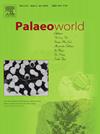A new fossil record of Adiantum (Pteridaceae) from Oligocene of Qaidam Basin, Northwest China and its palaeoenvironmental implications
IF 1.7
3区 地球科学
Q2 PALEONTOLOGY
引用次数: 0
Abstract
Adiantum, a genus of leptosporangiate ferns, belonging to the Pteridaceae, is characterised by marginal sori, reflexed pseudoindusia, and dichotomous venation. As a large and widespread genus, Adiantum includes about 225 extant species and a nearly worldwide distribution, but its fossil record is rather scarce. Here, we describe a new fossil species of Adiantum as A. qaidamense Chen and Yan, n. sp. based on fossil fertile and sterile pinnules from the Oligocene Shangganchaigou Formation in the western Qaidam Basin, Qinghai Province, China. These fossils are mainly characterised by three clearly marginal sori covered by orbicular or oblong pseudoindusia. Both morphological comparisons and cluster analysis indicate that A. qaidamense can be distinguished from previously known species, and A. capillus-junonis seems to be morphologically the most similar extant species. The discovery of A. qaidamense represents an unequivocal macrofossil record of Adiantum in China, and improves our understanding of the palaeogeographic distribution of the genus and the species richness of the Oligocene flora in the western Qaidam Basin. According to the habitats of extant Adiantum, the existence of A. qaidamense probably indicates that there was a flourishing forest growing on probable calcareous soil with abundant water availability during the Oligocene in the western Qaidam Basin.
柴达木盆地渐新世翼蕨属新化石记录及其古环境意义
钩蕨属蕨类植物,属于蕨类科,其特点是边缘茎、反折假工业和二分脉。作为一个大而广泛分布的属,天牛属包括大约225个现存物种,几乎分布在世界各地,但其化石记录相当稀少。本文根据柴达木盆地西部渐新统上干柴沟组的可育和不育小羽化石,描述了一种新的Adiantum化石种a. qaidamense Chen和Yan, n. sp.。这些化石的主要特征是3个明显的边缘孢体,被圆形或长圆形的假工业所覆盖。形态学比较和聚类分析均表明,柴达木属与已知种有明显的区别,而毛茛属是现存种中形态最相似的一种。柴达木属的发现,为柴达木盆地西部渐新世植物区系的古地理分布和物种丰富度的认识提供了一个明确的大化石记录。根据现存绝种木的生境,柴达木的存在可能表明,柴达木盆地西部渐新世在可能的钙质土壤上生长着繁茂的森林,土壤水分充足。
本文章由计算机程序翻译,如有差异,请以英文原文为准。
求助全文
约1分钟内获得全文
求助全文
来源期刊

Palaeoworld
PALEONTOLOGY-
CiteScore
4.00
自引率
5.90%
发文量
95
期刊介绍:
Palaeoworld is a peer-reviewed quarterly journal dedicated to the study of past life and its environment. We encourage submission of original manuscripts on all aspects of palaeontology and stratigraphy, comparisons of regional and global data in time and space, and results generated by interdisciplinary investigations in related fields. Some issues will be devoted entirely to a special theme whereas others will be composed of contributed articles. Palaeoworld is dedicated to serving a broad spectrum of geoscientists and palaeobiologists as well as serving as a resource for students in fields as diverse as palaeobiology, evolutionary biology, taxonomy and phylogeny, geobiology, historical geology, and palaeoenvironment.
Palaeoworld publishes original articles in the following areas:
•Phylogeny and taxonomic studies of all fossil groups
•Biostratigraphy, chemostratigraphy, chronostratigraphy
•Palaeoecology, palaeoenvironment and global changes throughout Earth history
•Tempo and mode of biological evolution
•Biological events in Earth history (e.g., extinctions, radiations)
•Ecosystem evolution
•Geobiology and molecular palaeobiology
•Palaeontological and stratigraphic methods
•Interdisciplinary studies focusing on fossils and strata
 求助内容:
求助内容: 应助结果提醒方式:
应助结果提醒方式:


